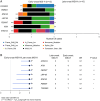Molecular characteristics of early-onset compared with late-onset colorectal cancer: a case controlled study
- PMID: 38742845
- PMCID: PMC11326018
- DOI: 10.1097/JS9.0000000000001584
Molecular characteristics of early-onset compared with late-onset colorectal cancer: a case controlled study
Abstract
Background: Early-onset colorectal cancer (EOCRC) is associated with a poorer prognosis relative to late-onset colorectal cancer (LOCRC), and its incidence has witnessed a gradual escalation in recent years. This necessitates a comprehensive examination of the underlying pathogenesis and the identification of therapeutic targets specific to EOCRC patients. The present study aimed to delineate the distinct molecular landscape of EOCRC by juxtaposing it with that of LOCRC.
Methods: A total of 11 344 colorectal cancer patients, diagnosed between 2003 and 2022, were enrolled in this study, comprising 578 EOCRC cases and 10 766 LOCRC cases. Next-generation sequencing technology was employed to assess the tumor-related mutation and tumor mutation burden (TMB) in these patients. PD-L1 expression was quantified using immunohistochemistry. Microsatellite instability (MSI) was determined via capillary electrophoresis (2B3D NCI Panel).
Results: Upon comparing LOCRC with EOCRC patients, the latter group demonstrated a tendency towards advanced TNM stage, lower tumor differentiation, and less favorable histological types. Among LOCRC patients, those with MSI-H status were found to have an earlier TNM stage compared to those with MSI-L/MSS status. Significantly, the incidence of MSI-H was notably higher in EOCRC (10.2%) compared to LOCRC (2.2%). Mutations in the 7-gene panel (ARID1A, FANCI, CASP8, DGFRA, DPYD, TSHR, and PRKCI) were more prevalent in LOCRC. Within the EOCRC cohort, patients with the MSI-H subtype displayed an earlier TNM stage but concurrently exhibited poorer tissue differentiation and a higher frequency of mucinous adenocarcinoma. Among EOCRC patients, FBXW7, FAT1, ATM, ARID1A, and KMT2B mutations were significantly enriched in the MSI-H subgroup. A comparative analysis of MSI-H patients revealed heightened mutation frequencies of FGFBR2, PBRM1, RNF43, LRP1B, FBXW7, ATM, and ARID1A in the EOCRC group. Furthermore, EOCRC patients demonstrated a higher overall TMB, particularly in the MSI-H subtype. PD-L1 expression was elevated in EOCRC and positively associated with MSI status.
Conclusions: This study revealed a significantly higher MSI-H distribution rate in EOCRC, and EOCRC exhibits a distinct mutational signature coupled with higher PD-L1 expression. These findings hold promise in guiding personalized therapeutic strategies for improved disease management in EOCRC patients.
Copyright © 2024 The Author(s). Published by Wolters Kluwer Health, Inc.
Conflict of interest statement
The authors declare that they have no competing interests.
Figures






References
-
- Bello RJ, Chang GJ, Massarweh NN. Colorectal cancer screening in the US—still putting the cart before the horse? JAMA Oncol 2022;8:971. - PubMed
-
- Lin JS, Piper MA, Perdue LA, et al. . Screening for colorectal cancer: updated evidence report and systematic review for the US preventive services task force. JAMA 2016;315:2576–2594. - PubMed
-
- Ros J, Matito J, Villacampa G, et al. . Plasmatic BRAF-V600E allele fraction as a prognostic factor in metastatic colorectal cancer treated with BRAF combinatorial treatments. Ann Oncol 2023;34:543–552. - PubMed
-
- Chen G, Jin Y, Guan WL, et al. . Neoadjuvant PD-1 blockade with sintilimab in mismatch-repair deficient, locally advanced rectal cancer: an open-label, single-centre phase 2 study. Lancet Gastroenterol Hepatol 2023;8:422–431. - PubMed
Publication types
MeSH terms
Substances
LinkOut - more resources
Full Text Sources
Medical
Research Materials
Miscellaneous

